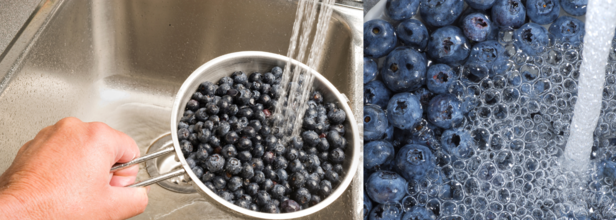- Health Conditions A-Z
- Health & Wellness
- Nutrition
- Fitness
- Health News
- Ayurveda
- Videos
- Medicine A-Z
- Parenting
- Web Stories
I Ate Only Khichdi For 7 Days- I Lost 5 Kgs, Controlled Cravings And Transformed My Skin

Credits: Freepik
There's something intensely comforting in a steaming bowl of khichdi. As a child, it was always my first port of call: little spices, a dollop of ghee floating on top, served with a dash of tangy pickle and a refreshing side of dahi. It's the sort of dish that envelops you in memories and feeds from within. But I went one step further with my passion for khichdi recently. I had just khichdi—only for each and every meal—seven days continuously. What began as a plain food cleanse became a life-changing experience for my body and mind.
Khichdi is not simply comfort food. It's an Ayurvedic traditional dish prepared with basmati rice and split mung beans, usually cooked along with a mix of digestion-friendly spices and plenty of ghee. This pot miracle is easy on the digestive system, has natural detox properties, and is nutritionally balanced. Ayurvedic doctors usually prescribe a khichdi cleanse in order to reboot the gut and regain balance—and that was precisely what I needed after a whirlwind month of traveling, processed foods, irregular sleep patterns, and no exercise.
A khichdi cleanse is not something to be undertaken lightly. You have to prepare your body by cutting down on processed foods and caffeine a few days beforehand. I entered grudgingly but with an open mind. The thought of eating the same meal 21 times in a week's time seemed daunting, but the outcome was beyond imagination.
First Signs: Detox is Uncomfortable
What shocked me the most? It wasn't the eating that was difficult—it was the recovery. For a month leading up to this cleanse, I had been living on poor food, late nights, and a non-existent workout schedule. I felt fat, lethargic, and sluggish at first. But only two days into the cleanse, my body began to react.
Detox isn't a happy process. Emotional and physical poisons emerged. I was irritable and fatigued. But by day four, the fog cleared. I awoke feeling lighter, more conscious, and with less sugar cravings. My digestive system improved significantly. My skin, which had been red and dull, began to clear. I even lost 5 kilograms at the end of the week.
Simplicity Is Powerful
One of the most surprising things about this cleanse was just how effective simplicity can be. Having the same simple meal every day streamlined not only my digestion, but my brain. There were no food choices to be made, no kitchen mayhem, no cravings to fill my head.
We tend to overcomplicate food with fad diets, complex meal preps, and a plethora of ingredients. But khichdi taught me that one dish, when properly nutritionally balanced, can be sufficient to provide us with everything we require. With split mung (which is full of protein), rice (a soothing carbohydrate), and ghee (nourishing fat), I was fulfilled in every possible sense.
Letting Go of Choices Brought Me Peace
At first, the prospect of having only khichdi seemed limiting. But somewhere between day three, I loved every bite. I ceased to compare it with other foods that I wasn't allowed to eat. I wasn't craving sandwiches or sweets. Rather, I was in the moment, relishing the tastes and textures of the food that I had in front of me.
Without constant food options, I was liberated. There were no what-ifs and menu regrets. I believed in the process, and with that belief came a astonishing sense of happiness.
Emotional and Mental Clarity
Discipline is tough. Particularly when the folks around you are indulging in all the things you're deliberately abstaining from. But holding firm on the cleanse showed me resilience. Every time I nearly gave up, I was reminded of why I began: to bring back balance.
This is not about food. It's about being reliably present for yourself, even when it's not convenient. The mental sharpness that I achieved was as impactful as the physical detox. I was able to concentrate more clearly, felt emotionally lighter, and started sleeping deeper.
The Body Always Knows
One of the deepest insights was this: our bodies know how to heal. They contain old wisdom that we tend to overrule with new ways—gobbling for boredom, stuffing late at night, or eating for pleasure rather than nutrition.
The khichdi cleanse brought me back in tune with the natural rhythms of my body. Hunger signals reappeared, sleep was effortless, cravings disappeared and all because I provided my body with what it was requesting and left it alone.
Food as Medicine
This cleanse redefined food for me. Food isn't pleasure, it's fuel. And when you use it as such, it pays off. My skin was healed, my bloating was gone, and I felt rejuvenated. All from one simple dish. Of course, I did miss variety. I missed crunch and spice but I also found something irreplaceable: an inner reset.
Would I Do It Again?
Absolutely. But in preparation. A khichdi cleanse isn't deprivation; it's discipline, healing, and getting back to basics. It's about listening to your body's intelligence and creating space for clarity, body and mind.
Although I don't advise attempting it without speaking with a healthcare provider, I do endorse the power of conscious, simple eating. Even if you do it one day a week, your body will reward you.
Why 'Old People' Have Body Odor? What Can They Eat To Prevent It?

Credits: Canva
The musty, cardboard-like scent often associated with older adults is widely recognized and just as widely misunderstood. Commonly referred to as “old people smell,” this odor isn’t a result of poor hygiene or a specific perfume — it's rooted in biology. As people age, their skin undergoes changes that make this scent more pronounced and persistent.
This distinct smell is caused by a compound called 2-nonenal, which forms on the skin due to lipid peroxidation — the process where fats in the skin oxidize. As antioxidant levels decline with age and cellular turnover slows, these oxidized fats accumulate on the skin's surface. The result is a lingering odor that isn’t easily washed away or masked with fragrance.
Why the Scent Lingers With Age
As the body ages, hormonal shifts and slower skin renewal contribute to the buildup of oxidized lipids. The body's ability to shed old cells and regenerate new ones becomes less efficient, making it harder to naturally eliminate the compounds responsible for the odor.
Additionally, typical cleansing methods like bathing or using deodorants don’t effectively break down the fatty acids responsible for the scent. This is why the smell can persist despite maintaining good hygiene.
The Role of 2-Nonenal and Lipid Peroxidation
The key culprit behind this age-related body odor is 2-nonenal, a byproduct formed when omega-7 fatty acids in the skin oxidize. This process, called lipid peroxidation, is essentially the skin’s version of rusting. Without sufficient antioxidant protection, especially as one ages, this oxidation accelerates.
Unlike typical body odor, which is caused by bacteria breaking down sweat, 2-nonenal comes from within — which means it can't be scrubbed off or covered with perfume. In fact, adding perfume often results in a more musty combination rather than eliminating the smell.
How Mushrooms Can Help from the Inside Out
The most effective way to address this odor is not external but internal — by targeting its root cause through nutrition. Enter mushrooms: a powerful superfood that offers several age-defying benefits.
Mushrooms are especially rich in ergothioneine, a unique amino acid and antioxidant that can halt lipid peroxidation before it leads to odor formation. Ergothioneine also has anti-inflammatory properties, helping the skin stay healthier and more resistant to oxidative damage.
Additionally, mushrooms contain spermidine, a natural compound that supports autophagy, the body’s internal “clean-up” system. Autophagy breaks down and recycles damaged cell components, promoting cell renewal and helping maintain healthier skin — and in turn, reducing the scent associated with aging.
The Best Mushrooms for the Job
While all mushrooms contribute positively to health, certain varieties are more potent when it comes to fighting age-related odor. Shiitake and oyster mushrooms stand out for their high levels of ergothioneine and spermidine, making them particularly effective in targeting the root causes of 2-nonenal buildup.
These mushrooms not only support better skin health but have also been linked to a lower risk of cognitive decline and chronic disease. Their benefits extend beyond odor prevention, offering immune support, cancer-fighting properties, and improved metabolic health.
More Than Just Odor Control
Incorporating mushrooms into the diet offers a range of age-related health benefits. In addition to curbing the development of the so-called “old people smell,” mushrooms have been found to:
- Lower blood pressure
- Improve insulin resistance
- Protect against brain damage
- Slow cancer progression
- Strengthen bones
Studies have also linked mushroom consumption with reduced risks of prostate and breast cancer. In some countries like Japan and China, mushroom extracts are even used alongside cancer treatments due to their immune-boosting effects.
Healthier Popcorn Alternatives You Can Try For Your July 4 Movie Nights

Credits: Canva
The Fourth of July is usually all about fireworks, BBQs, and patriotic playlists—but let’s not forget another tradition that’s gained popularity in recent years: movie nights at home. Whether you’re winding down from a long day of celebrations or just skipping the crowd to watch classics under the stars, a cozy night in calls for sweatpants, blankets, and of course, snacks.
Popcorn may be the go-to, but this Independence Day, consider breaking from tradition with some revolutionary snack choices. Did you know there are plenty of whole grains you can pop for a lighter, crunchier twist? Sorghum, amaranth, quinoa, and more—these ancient grains bring unique textures and flavors without the pesky hulls that stick in your teeth.
Also Read: These Steps Will Wash Blueberries The Right Way And Remove Pathogens And Pesticides Residue
Not All Grains Pop—But They Puff Beautifully
Let’s clear things up: most ancient grains don’t pop into fluffy, buttery clouds like corn does. Instead, they puff when heated. So, if you’re trying them for the first time, expect a toasty crunch rather than big, airy bites. But what they lack in size, they make up for in taste, nutrition, and charm.
1. Sorghum
If you’re new to puffing grains, start with sorghum. It looks like tiny popcorn and delivers a similarly satisfying crunch. Lauren Harris-Pincus, MS, RDN, calls it a “gluten-free, fiber-rich, antioxidant-packed” snack that’s grown right here in the U.S.
Bonus: Sorghum doesn’t have a hull, so there’s zero risk of those annoying popcorn bits in your teeth. Sprinkle it over salads, soups, or even ice cream for an unexpected Fourth of July twist.
2. Amaranth
Amaranth is a quick-popper and packs serious nutrition—think protein, fiber, and minerals. Lisa Richards, nutritionist and author of The Candida Diet, notes that it’s gluten-free and nutrient-dense. Its tiny size makes it ideal for mixing into granola bars, muffins, or DIY cereals. Puffed amaranth adds a fun crunch to yogurt parfaits or fruit bowls at your 4th of July breakfast table.
3. Barley
While barley doesn’t exactly pop, it does crack and puff slightly, resulting in a chewy, nutty snack. It’s not the flashiest grain, but it delivers a mellow, toasted flavor perfect for a post-fireworks wind-down snack.
4. Buckwheat
Puffed buckwheat doesn’t just sound fun—it’s actually delicious. Crunchy and tender, this grain works best as a topping on oatmeal, fresh fruit, or nut-butter toast. If you’re not up for DIY puffing, try pre-puffed options like Lil Bucks for easy snacking.
5. Quinoa
Quinoa pops small, but brings bold flavor. While its shape doesn’t change much, its texture gets light and crisp. Try puffed quinoa on salads, in trail mix, or as a cereal replacement for a healthier holiday breakfast.
Also Read: This Year, Doctor's Day Reminded That Doctors Too Are Humans And Can Get Emotionally Exhausted
How to Puff Ancient Grains?
Puffing ancient grains is surprisingly simple—no oil required! Here’s how to do it:
- Heat a medium saucepan over medium-high heat until a drop of water sizzles and evaporates.
- Add grains in a single layer, and shake the pan frequently.
- Listen and watch: grains will crackle, puff, or lightly brown. Remove promptly to avoid burning.
- Each grain reacts differently to heat, so keep an eye on texture and color. Overheating can result in bitterness.
These Steps Will Wash Blueberries The Right Way And Remove Pathogens And Pesticides Residue

Credits: Canva
On Tuesday, the US Food and Drug Administration (FDA) announced a recall of 12,000 pounds of organic bulk blueberries which was distributed by Alma Pal International LLC. According to the agency, the blueberries have been tested positive for Listeria monocytogenes, a potentially dangerous bacteria known to cause foodborne illness.
READ: FDA Recalls Blueberries Over Listeria Risk Ahead of July 4th Festivities
Amid all this, one question that concerns many is how to wash blueberries the right way?
While water alone can remove debris, food scientist Bryan Quoc Le, Ph.D., says, as reported in marthastewart.com that it is not enough to eliminate pathogens or pesticide residue.
However, there are tips and tricks that can remove such residue. For this, your household staples like white vinegar or baking soda can work.
Vinegar's low pH makes it very effective at dissolving certain pesticide residues and inhibiting bacterial growth. Baking soda too works well when it comes to neutralizing bacteria through its alkaline nature. However, it may leave a bitter residue if it is not rinsed properly.
Also Read: Healthier Popcorn Alternatives You Can Try For Your July 4 Movie Nights
Why Isn't It Enough To Just Rinse Blueberries With Water?
Simply rinsing blueberries with water may wash away visible dirt, but it’s not enough to tackle bacteria, mold, or pesticide residues. According to Le, using vinegar or baking soda is more effective, as both alter the pH of the berry’s surface—creating an environment that disrupts microbial growth and helps extend shelf life better than neutral water.
Washing Trick: Why Do Baking Soda and Vinegar Work?
Baking Soda
As an alkaline cleaner, baking soda is effective against a different range of bacteria. However, it may leave a slightly bitter residue if not rinsed off thoroughly.
Vinegar
White distilled vinegar is ideal for cleaning produce. Its acidity helps break down certain pesticides—especially those with a basic pH—and inhibits bacterial growth. “It’s the pH that matters, not the vinegar type,” says Dr. Le. Apple cider vinegar works too, but white vinegar is more affordable and equally effective.
How To Clean Blueberries The Right Way?
For vinegar wash, follow these steps:
- Start with mixing 3 parts cold water to 1 part white vinegar. Use a large bowl to mix properly.
- Now, add blueberries and let it soak for 5 to 10 minutes.
- Wash your hands and then you can then wash the blueberries thoroughly, rub it with your hands to help loosen debris.
- Once done, drain the water and wash the blueberries again with running cold water to remove any vinegar residue
- Dry completely on a clean dish towel or paper towel before you store it in the refrigerator.
For baking soda wash, follow these steps:
- In a large bowl, dissolve 1 teaspoon of baking soda in 2 cups of cold water. Stir well until fully mixed.
- Gently add the blueberries to the solution and let them soak for 5 to 10 minutes. This helps loosen dirt, bacteria, and pesticide residues.
- Drain the berries and rinse them well under cool running water to remove any remaining baking soda.
- Spread the blueberries out on a clean dish towel or paper towels and pat them dry. Let them air dry completely before storing in the refrigerator to prevent mold growth.
Note: Make sure you do not soak the blueberries for longer than 15 minutes. Food scientist warns that the skin can begin to degrade if the blueberries are soaked for too long and it can cause flavors to dissolve in the cleaning solution.
© 2024 Bennett, Coleman & Company Limited

